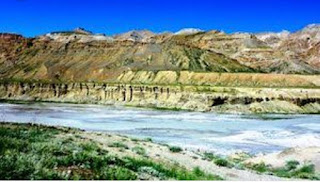The Chenab River is a major river that flows in India and Pakistan and is one of the five major rivers of the Punjab region. It is formed by the union of two headwaters, Chandra and Bhaga, which rise in the upper Himalayas in the Lahaul and Spiti district of Himachal Pradesh state, India.
The length of the river is 960 kilometers. It flows through
the path areas in India: Lahaul – Chamba – Kishtwar – Thathuri – Doda – Ramban
– Akhnoor. The bridges above the
river are the Chenab rail bridge (the world's highest bridge),chiniot bridge. The
other name of this river is Chanderbhaga. The Mouths of this river are Sutlej River, Indus
River, Panjnad.
Sanskrit's name of this river is Asikni. The waters of the
Chenab was allocated to Pakistan under the terms of the Indus waters treaty.
India is allowed non-consumptive uses such as power generation. The Chenab
river is extensively used in Pakistan for irrigation. Its waters are also transferred to the channel of the Ravi
river via numerous link canals.
In 325 BC, Alexander the great allegedly founded the town of
Alexandria on the Indus at the confluence of the Indus and the combined stream
of Punjab rivers.
Credits: Pooja


Comments
Post a Comment